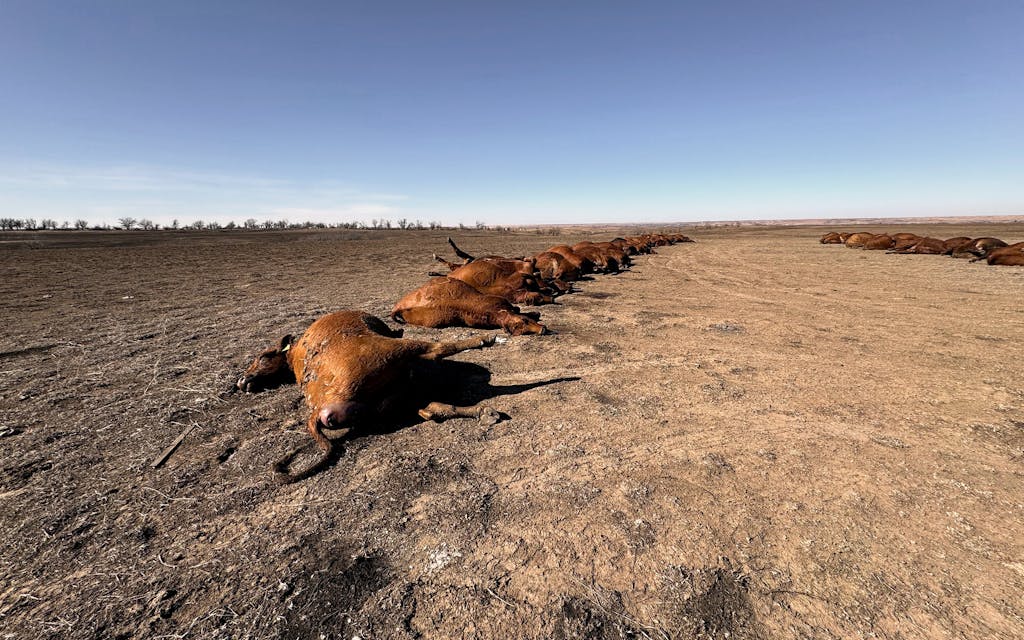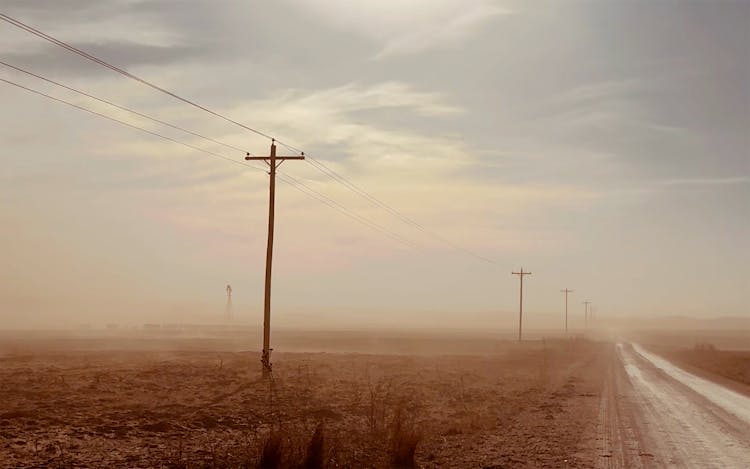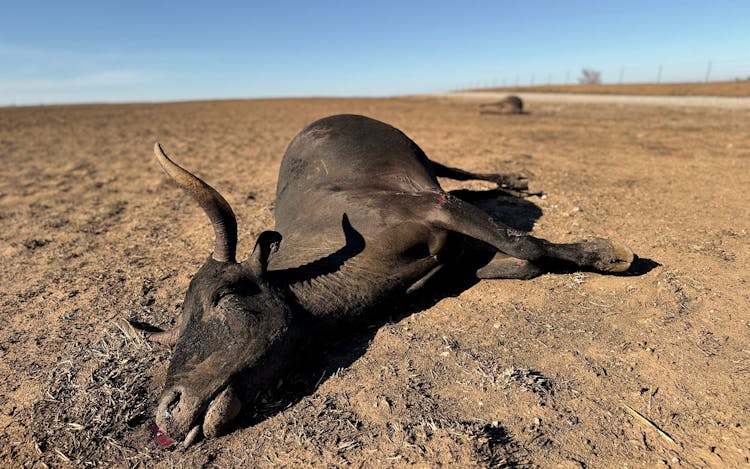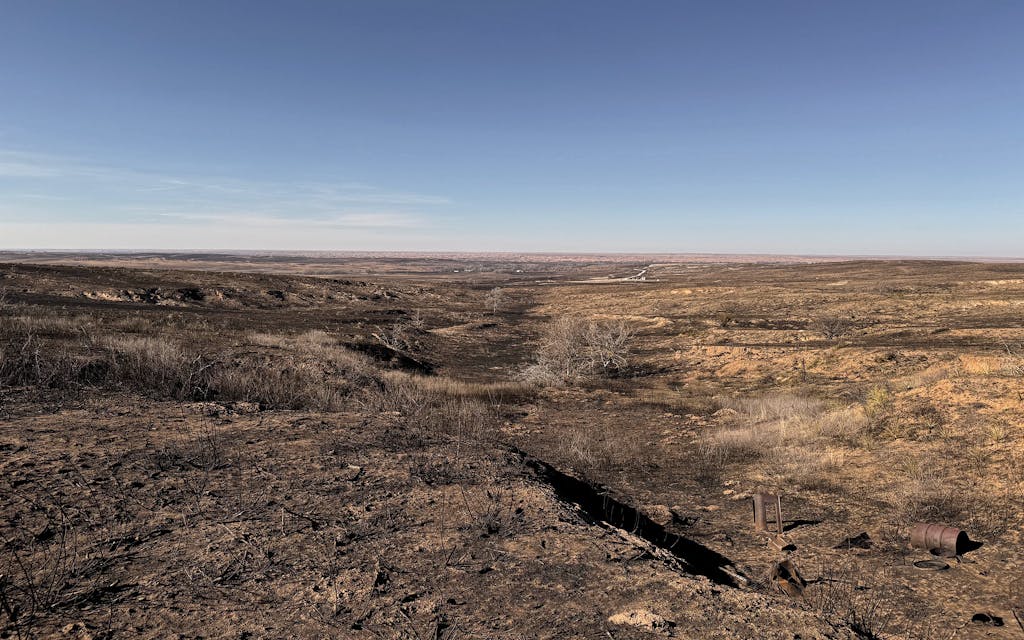- What to do during a tornado warning
- Storm damage reported after possible tornado in Union County
- Live updates: Severe thunderstorm warning issued for Durham & Chapel Hill; reports of possible tornado damage near Charlotte
- Storm damage reported in Union County, NC
- Live updates: 1st tornado warning of the day issued for Forsyth County
After a Wildfire Killed Thousands of Cows, Texas Ranchers Quietly Count Their Losses

After a Wildfire Killed Thousands of Cows, Texas Ranchers Quietly Count Their Losses
On the rolling hills outside Canadian, Texas, where cattle herds were decimated and fertile ranchland has been reduced to a charred wasteland, some things are too painful to discuss.

Photograph by Peter Holley
A few days after the largest wildfire in Texas history had torn through Hemphill County, the locals in Canadian—the charming Panhandle town a hundred miles northeast of Amarillo—all seemed to understand something that outsiders like myself could not: no matter how many journalistic overtures were made, no matter how many pleasantries included, area ranchers, among the hardest hit by the fires, were not going to talk about their ordeal—at least not yet, anyway.
Initially, this recurring message seemed hard to believe. During most instances of calamity, be it violent crime or natural disaster, some victims are almost always willing to share their experiences. In Sutherland Springs, I spoke to a woman in her home 24 hours after a gunman’s bullet had left a golf ball–size hole in her shoulder. She, like so many in that sorrow-filled community, needed to tell the outside world what had happened to her. What could be so different, I wondered, about Texans five hundred miles to the north in the wake of the Smokehouse Creek fire?
Instead of seeking to ask ranchers questions, a county official told me, I should simply drive down some of the remote county roads between Canadian and the Oklahoma border. “I guarantee you’re going to see something,” he added, ominously.

With the help of a map, I started out my journey along Texas Highway 33, a two-lane road that begins a few miles south of town and ends on the other side of the Oklahoma state line. Here, among the vast, rolling prairie east of town, where the horizon disappeared into a haze of gray smoke, it looked like the earth’s outer layer had been peeled back with a giant blade. Where just a week ago, hundred-year-old live oaks dotted dense grassland, an eerie moonscape—naked, desertlike, and sepia-toned—had quickly taken its place. In this apocalyptic-looking expanse, where the air reeked of burnt manure, the landscape was still being transformed 72 hours after area fires were extinguished. Amid the charred trees, melted fence posts, and windblown dust that blocked out the sunlight, the most obvious signs of life were no longer living. The first: a soot-stained badger that had curled into a ball and died, fully intact, beside the road. Several hundred yards east, dead cows began to appear like black boulders in the middle of empty fields. In some areas, ranchers had begun lining them up in rows for burial in large, earthen pits carved from the soil using backhoes. In one field, multiple rows of dead cattle stretched more than a hundred yards—a giant assembly line of rotting flesh with too many victims to count.
Inspecting the cow carcasses revealed clues about the animals’ demise. Some cattle spent their last moments crowded together, seeking safety in numbers. Others defied herd instinct, fleeing on their own as a sky-high tsunami of black smoke and fire closed in at highway speeds. The lucky ones survived by finding small islands of refuge amid the sea of flames—a dirt-covered hill here, a water-logged pasture there. The unlucky ones found themselves encircled by darkness, with nowhere to run. Ranchers would eventually discover thousands of them keeled over in distant fields or trapped by iron fences and cattle guards, many just a few feet from salvation, like an act of divine cruelty. Suddenly, local ranchers’ inability to open up about the loss of so much life began to make sense. “It will be a little while before I can discuss it,” one rancher told me via text a day later. “We are still picking up the pieces.” Another, reached by phone, apologized when asked to comment on his family’s sizable loss. “I just can’t right now,” he said. “It’s too much.”


In remote portions of the Panhandle—where cell service is sporadic and Texas’s daily rituals are dictated by the needs of the herd—few events fall into the “too much” category. As cliché as it may sound, these Texans are, and have long been, a hardened, self-sufficient bunch. Like their parents and grandparents before them, they’re no strangers to physical toil and punishing weather, from icy winters and scorching summers to tornadoes, droughts, and, of course, wildfires, the most recent big one occurring in 2017. But what happened last week, according to many county residents, is an altogether different kind of tragedy. Many of the fifty or so families that lost their homes can rebuild. With a little luck and some timely rains, the prairie will eventually heal. The same cannot be said of the cattle, which many ranchers see as a gift from God that they were born to steward so that the rest of us—the mass-market consumers—can feed our families. “When you have a cow that lives with you for ten years, producing one calf every year, you get to know that cattle, even if you’ve got five hundred others,” said Hemphill County extension agent Andy Holloway. “It’s no different than going to a high school and having five hundred classmates. You know all of them, and it’s the same way out on the ranch. It’s like these cattle are our family.”
It can be difficult to envision the scale of the damage those family members have endured across the Panhandle, let alone in and around Canadian. The perfectly square Hemphill County, which borders Oklahoma on its eastern edge, contains nearly 600,000 acres—around 80 percent of which burned last week, officials estimate. Though the exact number of cattle lost in the blaze remains unknown, county officials estimate as many as 10,000 were killed, which represents around 40 percent of the local population. County officials say numerous ranchers lost hundreds of thousands of dollars worth of cattle and that many more have total asset losses in the millions. Ranchers with surviving cattle face deepening challenges. Much of the grass needed to keep their cattle alive was also torched. To pump the water out of wells that livestock rely on for survival, ranchers need electricity, which has been in short supply ever since fire destroyed power lines across the region. “There was just boiling smoke everywhere, and what amazed me was the actual walls of towering smoke,” Hemphill County Judge Lisa Johnson said. “Somebody compared it to Armageddon, and it certainly felt like that.”
Had last year’s rains been torrential, the kind that pound the earth from above, dumping far more water than the ground can absorb, there’s a chance things may have turned out differently. But the rains were as close to perfect as precipitation can be on the High Plains of the Texas Panhandle, the kind of gentle, soil-soaking events that fill the ground with moisture and beckon native grasses upward. “A lot of ranchers said they’d never seen that much grass,” Holloway said, recalling the upbeat mood among Hemphill County landowners last summer.
But by the fall, after months of rainless, triple-digit temperatures, that same thick, lush grass had dried out and died, turning it into high-powered fuel. When a spark eventually arrived last week in the form of high winds, low humidity, and an unknown source of fire, Holloway, and countless other ranchers, was hardly surprised. “Texas A&M AgriLife identified this as a problem back in August, and we had programs in November to try to get people prepared for this moment,” he said. “We had a pretty fair turnout in a meeting or two, but it should have been ten times the number of people.”

Today, many ranchers are faced with a painful economic dilemma: sell their cattle now, or invest in feed, hay, and supplements and hope the grasses return as soon as possible. “We should start getting good, decent, measurable spring rain in April and then see grass in May,” said Trey Webb, the owner of Flap Air Helicopter Service, which has been assisting firefighters and helping ranchers track down missing cattle over the past week. “But we still have a good six weeks or more of true wintertime, and we can’t rule out a spring blizzard at some point.” Without adequate moisture, ranchers say, another possibility looms: high winds could continue to pick up the county’s sandy, ash-covered terrain and deposit it in places where grass and brush used to grow, eventually forming dunes that could take years to dissipate. If that happens, the county’s recovery will be even longer and more brutal.
From his office in downtown Canadian, Holloway said the memories of the lost animals will take years to dissipate as well, if they ever do. Not every rancher gets attached to their cattle, but many, including Holloway, most certainly do. Growing up in a ranching family, he told me that his father—like many others who make a living raising livestock in the Panhandle—had an unbreakable rule: you can’t eat a meal until you’ve fed your cattle. “That was our philosophy and the philosophy of people in this part of Texas: we take care of our animals before we take care of ourselves,” he said. “That’s why this fire hurts so much, because so many of us weren’t able to live up to that promise.”
